Recent years have seen a significant rise in the importance placed on anti-ship missiles, and the most prominent of these missiles has been the Naval Strike Missile (NSM)1 developed by Norwegian defense contractor Kongsberg. NSM offers a major improvement in capability over legacy missiles like Harpoon and Exocet, and while competitor missiles have begun to emerge in recent years, NSM was good enough to be adopted not only by much of NATO but also by the United States, which is famously hostile to foreign systems.2
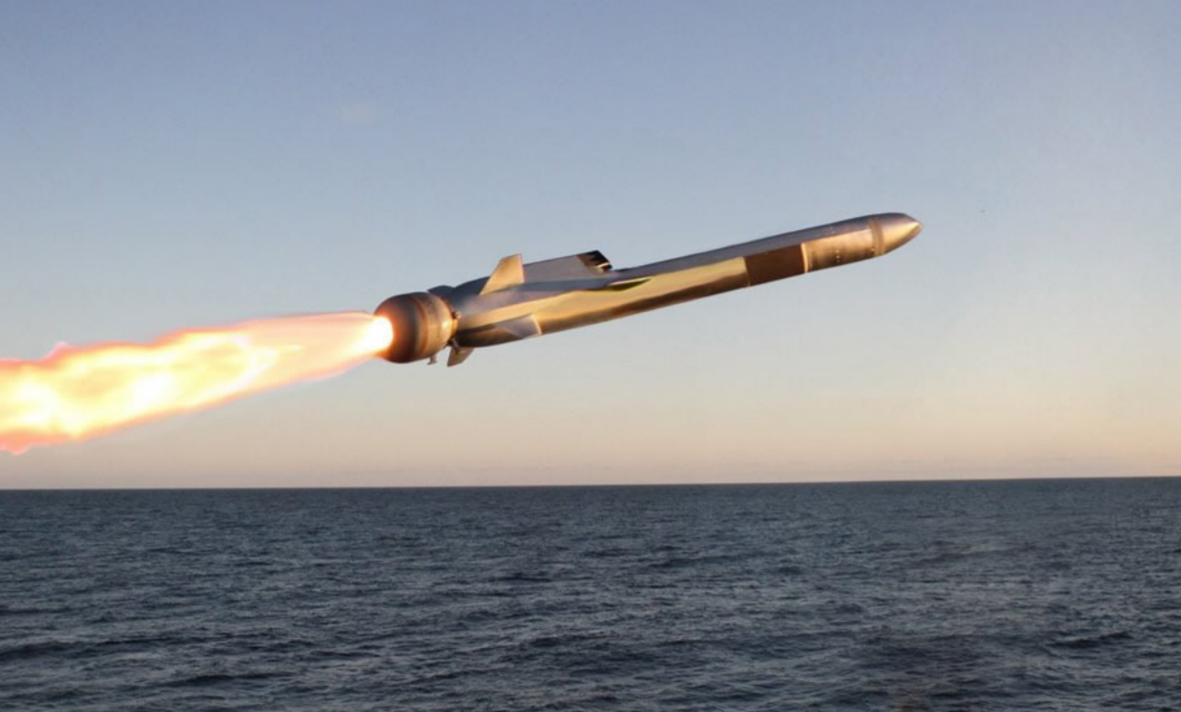
An NSM is launched
Norway had long maintained an indigenous defense industry, and it had been the first NATO power to introduce a proper anti-ship missile in the form of Penguin, a small weapon intended for use from missile boats and aircraft. As they were primarily expecting to use Penguin in coastal waters full of fjords and islands, the missile was equipped with an inertial navigation system to allow it to take advantage of terrain and fitted with an IR seeker instead of radar guidance, considerably reducing the odds that it would waste itself on a rock. Penguin was exported to a number of countries, including Sweden, Brazil, Greece, New Zealand, Spain, Turkey and, shockingly, the United States, who apparently didn't see it as worth the bother of developing an anti-ship missile for use by its helicopters.
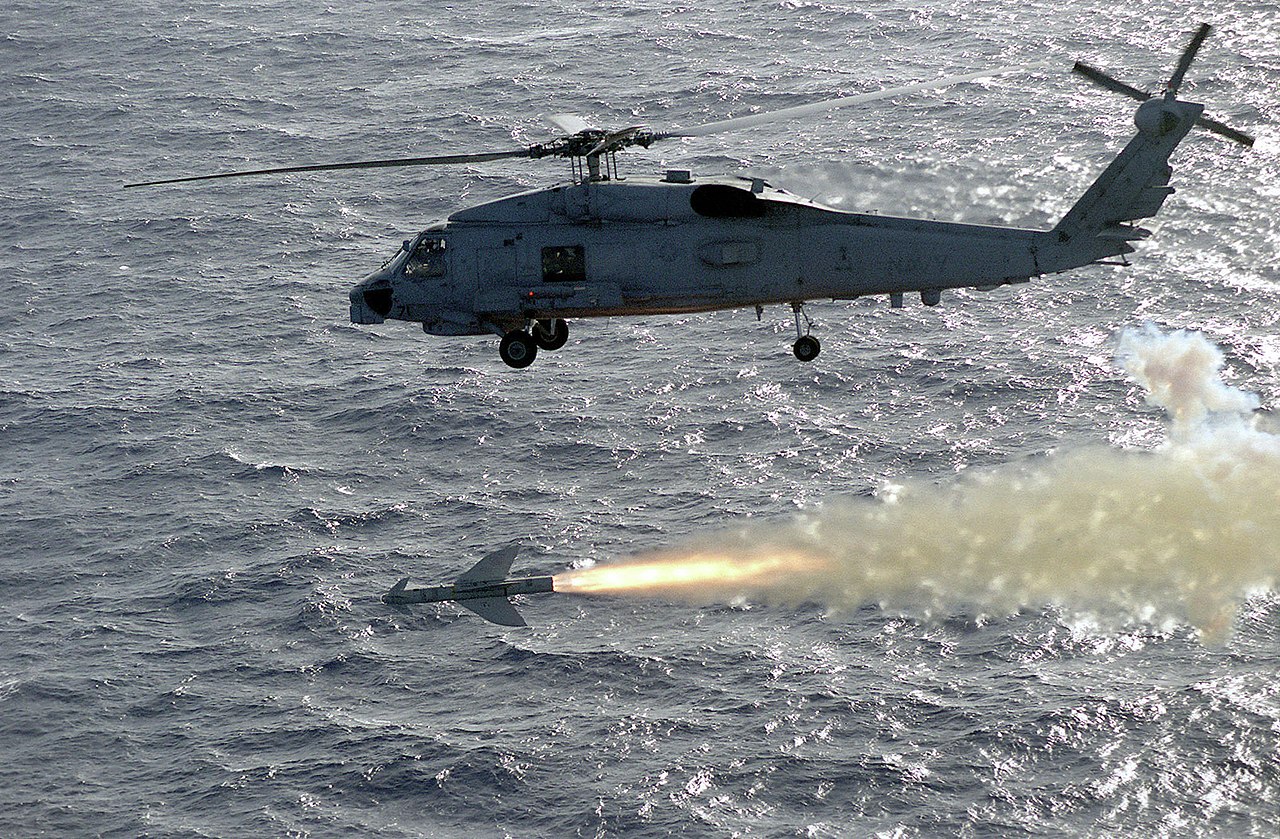
A Penguin launched from an SH-60
But by the 80s, Penguin's limitations were becoming more obvious. Its warhead, designed for use primarily against coastal craft, was only 250 lb or so (half that of, say, Harpoon), giving it limited capability against larger vessels, and even the longest-range version couldn't reach beyond 30 nm or so when air-launched. There were also concerns about collateral damage, as the guidance system was pointed in the general direction of the target and told to blow up anything that looked like a ship, and about penetrating the increasingly capable defenses that were appearing on the world's warships. Dealing with all of these problems without pushing the size and cost of the missile up too much was a daunting challenge. Work began in the late 80s, with the contract for full-scale development signed in 1996. Development was expected to take about 6 years and cost around $110 million, but technical problems uncovered tacked on at least 5 years and added 20% or more to the cost. Full service entry finally came in 2012, when it was placed about the frigate Roald Amundsen.
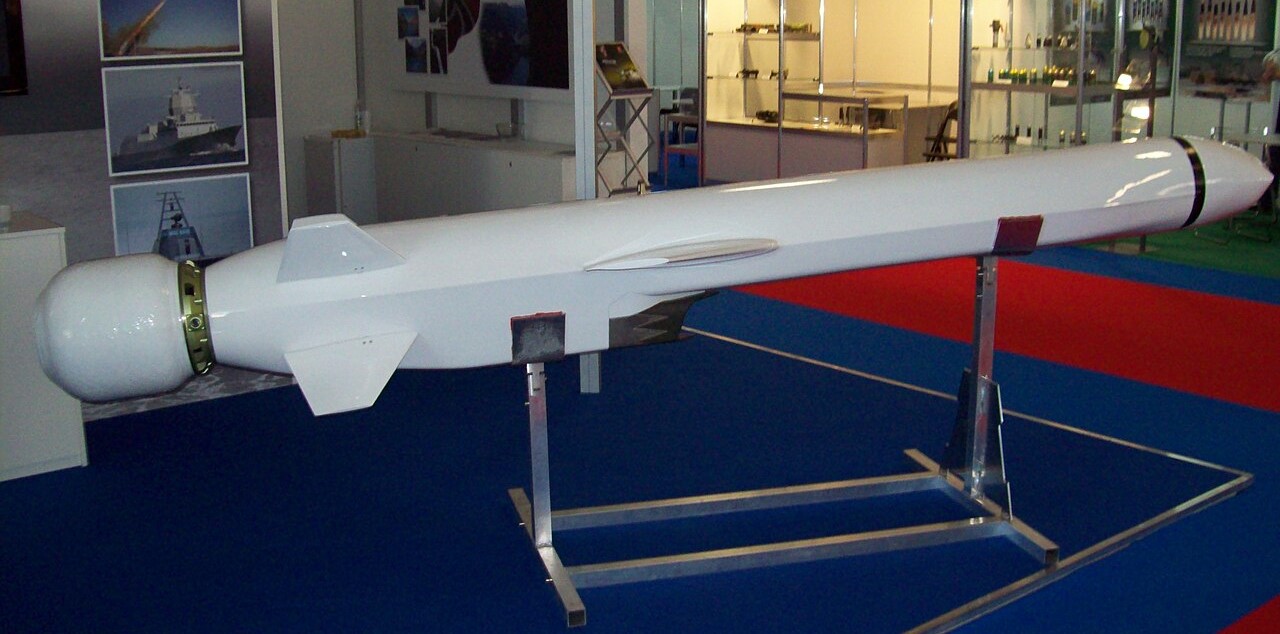
An NSM on display
The NSM missile itself is on the smaller side, only about 400 kg (900 lb) including the booster to fling it into the air, which means a warhead not much bigger than Penguin. To enhance lethality and avoid collateral damage, it is guided by a dual-band3 imaging infrared seeker4 capable of not only distinguishing a target ship from a passing tanker, but also hitting a specific point, either for maximum damage or to send a strong signal without killing too many people. This is aided by the 120 kg warhead's titanium penetration case, capable of taking it deep into the ship, and a fuze can count how many bulkheads it has penetrated to make sure it goes off in exactly the right place.
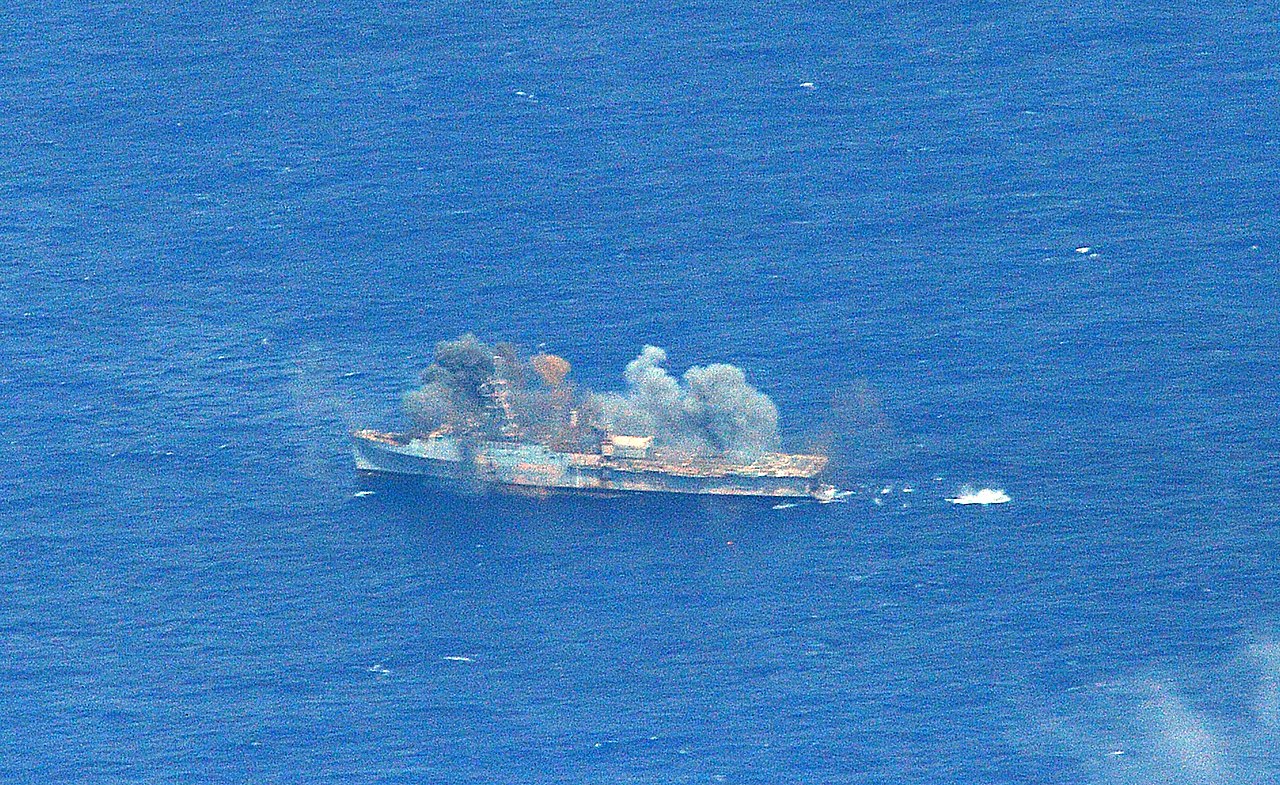
USS Ogden hit by an NSM during RIMPAC 2014
A major part of the strategy to bring down the cost of NSM was to make sure that each missile had a high probability of hitting and damaging the target. The sophisticated seeker was a large part of this, as it not only allowed the missile to hit a specific point on the target, but also gave excellent resistance to decoys and other passive defenses. Kongsberg considered making the missile supersonic to help penetrate active defenses, but ultimately settled on stealth as the best way to go, shaping the missile's airframe to reduce its radar signature, particularly in the bands used for fire control. It also flies very low, probably around 30' above the sea, thanks to a stabilized laser altimeter which also gives it a TERCOM capability to go with the the GPS and inertial navigation systems. This also gives it a secondary land-attack mode, an increasingly important feature as smaller navies increasingly seek to influence events ashore. This is supported by a sophisticated mission-planning capability, which can handle everything from simple tasks like "look for this ship in this area, and attack from this direction" to a sophisticated time-on-target attack from multiple axes with minimized possibility of counterdetection. To get the required 200 km (110 nm) range, a small turbojet engine was used, although it was considerably more powerful than is typical on most cruise missiles, allowing a stated speed of Mach .95. The engine, which provides a thrust-to-weight ratio greater than 1, also enables the missile to conduct high-G evasive maneuvers shortly before impact with no loss of speed, further enhancing its ability to penetrate defenses.5
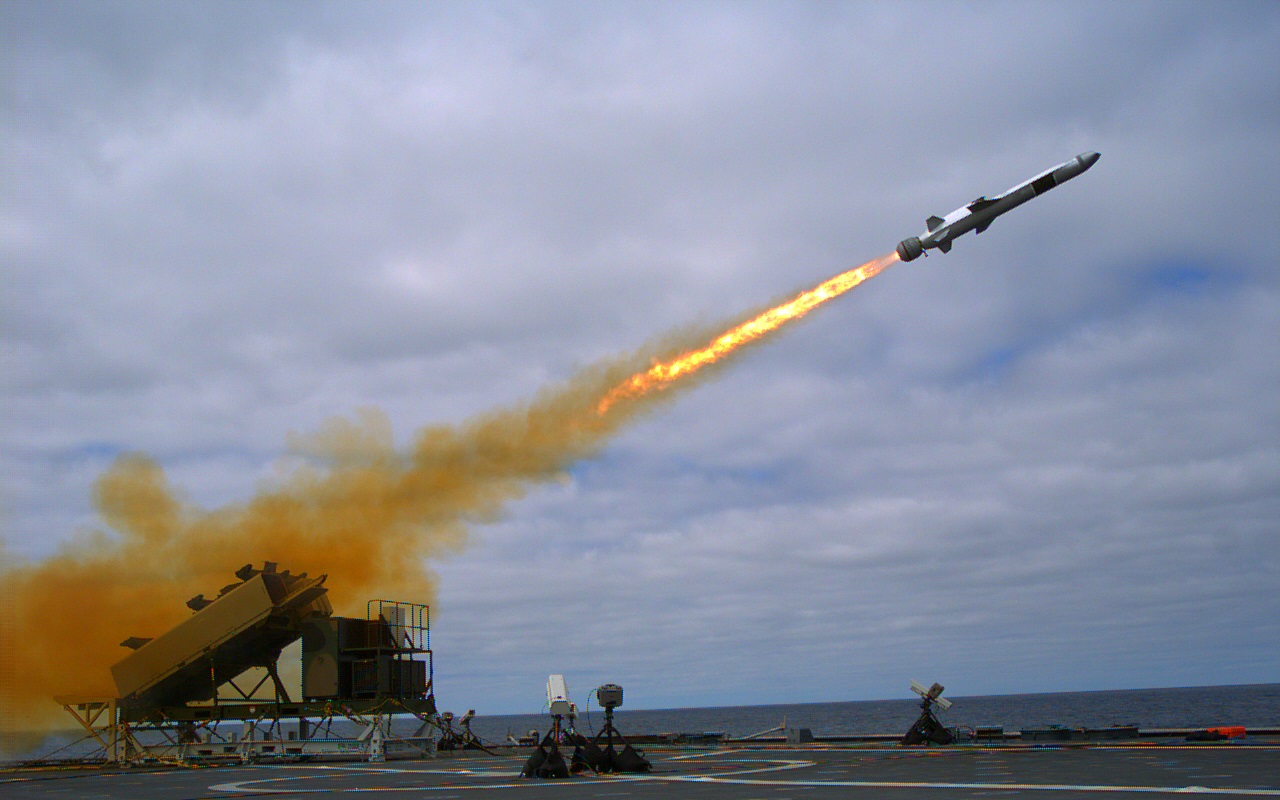
The first USN NSM test in 2014
NSM was an almost instant export success. Even before it entered service, Poland ordered it as part of a truck-mounted coastal-defense system from Kongsberg, and the company mounted a successful campaign to sell NSM as a possible solution to the Littoral Combat Ship's lack of offensive punch. The missile was tested aboard USS Coronado in 2014, and a formal order was placed in 2018, with Kongsberg teaming up with Raytheon to produce the missiles at the latter company's Tucson plant.6 Two quad box launchers are being installed on all LCSs, and 16 missiles are planned for the new Constellation class. The Marine Corps has also ordered NSM as part of their new EABO concept, firing it from remote-controlled trucks as part of their shift to participating in the battle for control of the sea.7
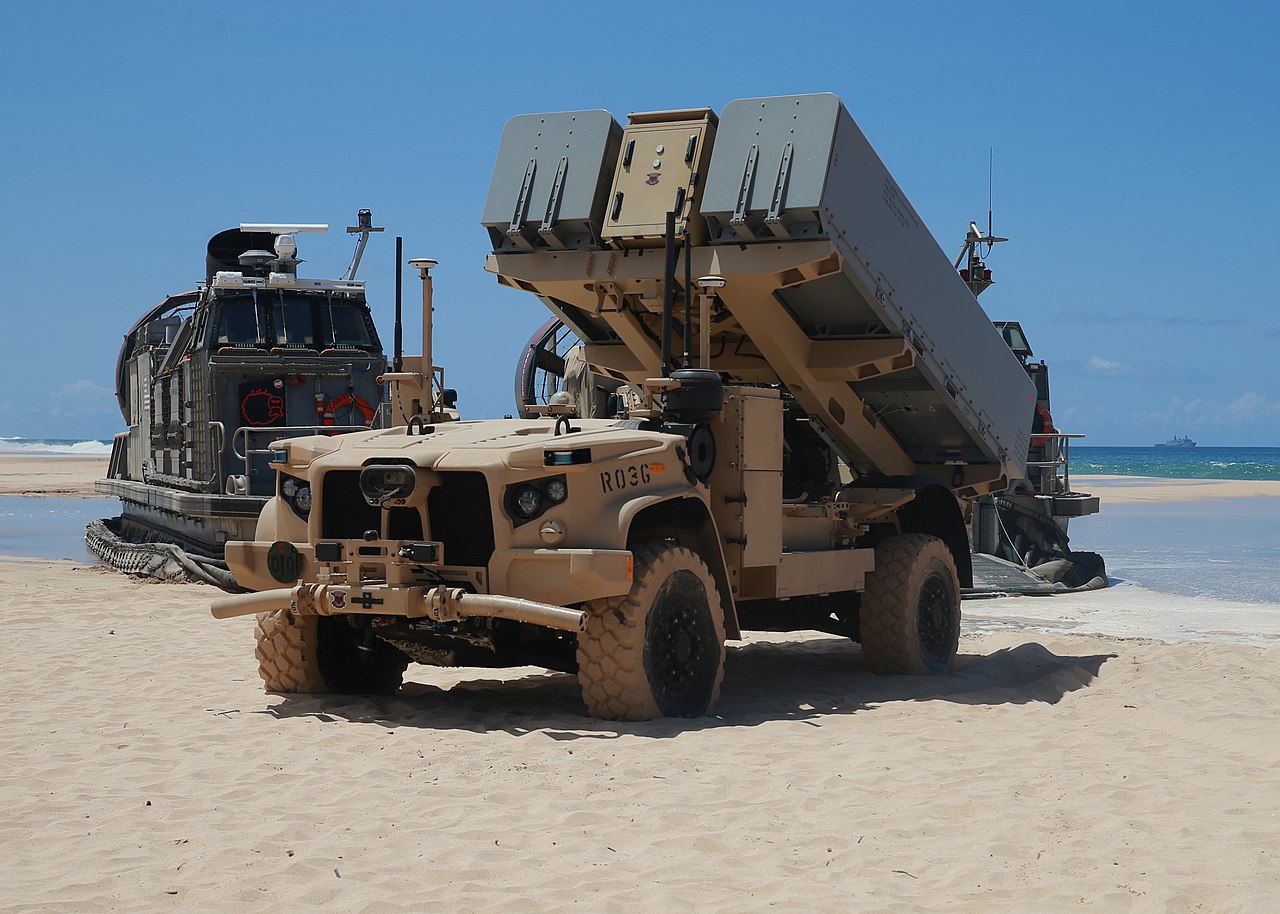
Marine NSM launchers
Nor has its success been limited to the US. NSM is now in service with a fourth customer, the RN, where it is replacing Harpoon. And it is on order by Australia, Belgium, Canada, Germany, Indonesia, Malaysia, the Netherlands and Spain for shipboard use, while Latvia and Romania have acquired the coastal-defense version. The sheer number of export successes, particularly among NATO members, have led to jokes about NSM actually standing for "NATO Strike Missile", and it is rapidly becoming the de-facto standard for current-generation anti-ship missiles.
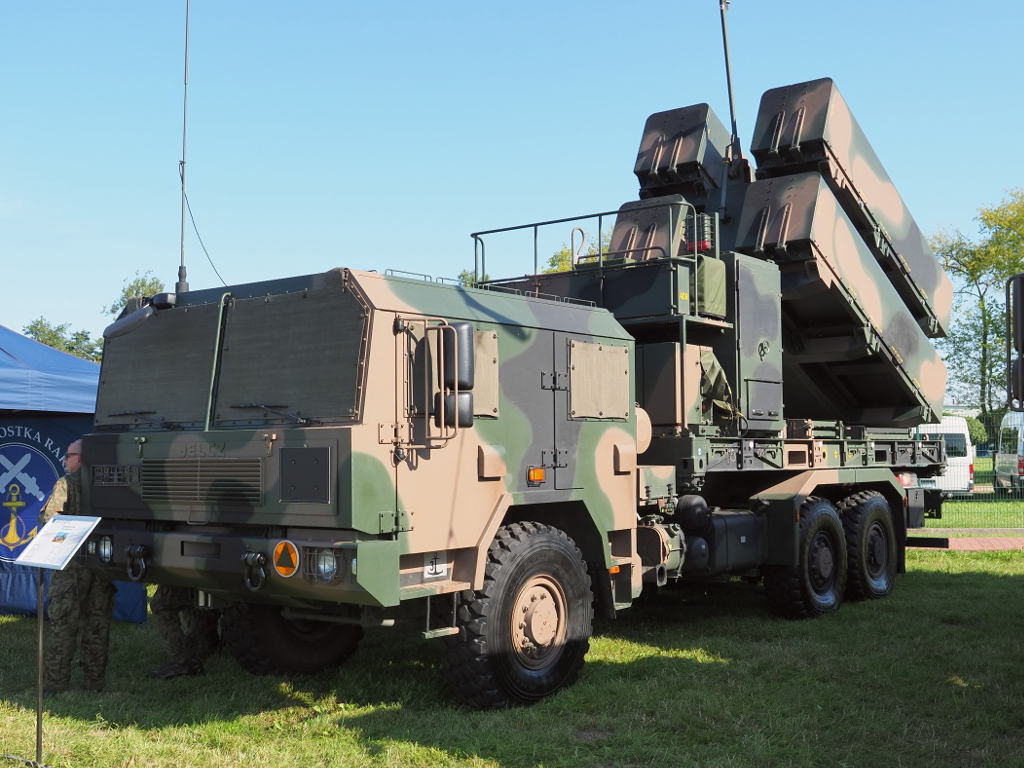
A Polish NSM launch truck
Development on NSM and its broader family has continued. During development, options discussed included a two-way datalink to allow inflight targeting updates, the addition of more sensors to improve targeting capability (most likely passive RF) and a stretched body for greater range. It's unclear what the status of these is, but the first major upgrade, known as Block IA, included an upgraded computer, some software improvements to give about 25% more range, and the ability to use the IIR seeker when attacking land targets. One planned variant that has so far not come to fruition is an air-launched NSM, despite Kongsberg's best efforts to sell it for either fixed-wing or helicopter use.8
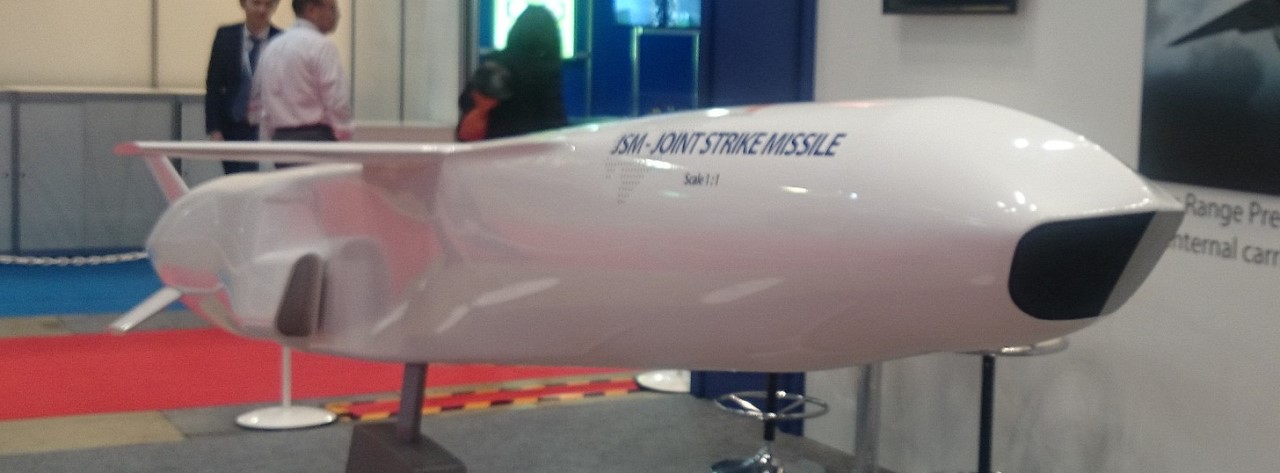
A JSM mockup
Instead, that market seems likely to be the preserve of the Joint Strike Missile, a joint US-Norwegian missile designed to fit into the weapons bay of the F-35. It's somewhat longer than NSM, giving it greater range9 and possibly a bigger warhead. It is intended from the start as a weapon capable of both naval and land attack, and some technology from it has fed back into improved NSM derivatives. Kongsberg has also noticed that JSM fits nicely into a VLS cell, and proposed a vertically-launched version as an alternative to VL-LRASM in case the US Navy ever gets around to actually buying a proper anti-ship weapon for the Mk 41. It's not entirely clear when JSM will enter service, but it should provide aircraft (and possibly ships) with an interesting lightweight strike capability when it does.
In NSM, Norway has managed to produce a world-class weapon, one that was at least 5 years ahead of any similar weapon, and a full decade ahead of most of its competitors. Their efforts have been rewarded with broad export sales, and the NSM/JSM family promises to be a critical weapon in the arsenal of the US and its allies for decades to come.
1 NSM originally stood for Nytt sjømålsmissil, "New Sea Target Missile", and the name was changed when the weapon was marketed to the wider world. ⇑
2 Of course, the US being the US, it did insist that its NSMs be built by Raytheon. ⇑
3 This means that it looks at two wavelengths of infrared light, making it harder to fool. ⇑
4 Note that this distinguishes NSM from most other ASMs, which are radar-guided for all-weather capability. Kongsberg claims that their analysis shows that IR homing will work the vast majority of the time, and that the other advantages of the system are worth it. ⇑
5 Note that we're dealing with a subsonic weapon with a fairly high lift/drag ratio, so this doesn't violate the laws of physics, unlike in the hypersonic case. ⇑
6 This has reportedly led to headaches when the Norwegians visit because of classified programs elsewhere in the building. ⇑
7 They've also ordered the Maritime Strike Tomahawk for this role, presumably because NSM is a bit short-ranged. ⇑
8 The design is definitely built for air-launch, which shows up in some amusing ways. It uses an aircraft-type MIL-STD-1760 data connection, and is supported by two aircraft-style lugs on the top of the missile. This is true even for the surface-launch version, which is why the missile is launched upside-down. ⇑
9 Wikipedia gives numbers of 550 km if it cruises at high altitude most of the way and 185 km if it stays low, both of which seem plausible. Kongsberg themselves say >275 km (150 nm). ⇑

Comments
If there's no air-launched NSM, does that mean we are giving up on helicopter ASuW strike capability? Hellfire seems too small and short-ranged for engaging a modern corvette or even FAC, and Penguin is getting kind of long in the tooth.
Penguin has been gone for 20 years. I think the theory is that Hellfire is enough for FACs (range isn't really an issue, given the problems those tend to have with air defenses) and I guess they're hoping that some Harpoon-shooter will be around to handle corvettes. That said, I wouldn't be surprised to see a helicopter-launched variant of JSM appearing at some point before too long.
Anglo-French Sea Venom is perfect Penguin replacement for heli. 120 kg overall mass, including 30 kg warhead, 20 km range, IR guidance.
Kongsberg, with an 'e'. You're thinking of German 'burg', city, but want Norwegian 'berg', mountain. It was originally the King's mountain because it contained silver. We do have some placenames ending in 'borg', castle, but they are named for the specific kings that built the fortification, as in Oscarsborg, not kings in general.
Blast. Every time I go anywhere near Norway or Norwegian stuff, this happens.
Fixed.
Typo in footnote #3; "...it looks at two wavelengths [if] infrared light...".
@RolfAndreassen German "-burg" in city names indicates a castle or fortress, some fortified place. "City" would be "-stadt".
@EngineOfCreation @RolfAndreassen "-berg" means mountain in Deutsch as well as Norwegian.
Late to the party, but why is the NSM so successful?
It’s got a smaller warhead than the Harpoon. An anti ship missile should have at least a 200kg+ warhead to critically damage or sink big ships.
That's where the ability to figure out exactly where to hit on the target comes in. A Harpoon is basically going to hit somewhere, and so the warhead needs to be big enough to have a reasonable probability of doing critical damage no matter where that is. But if you can specifically target the CIC, then you have a mission kill with a much smaller warhead. Sinking is nice, but not really worth it when you can cut missile size so dramatically.